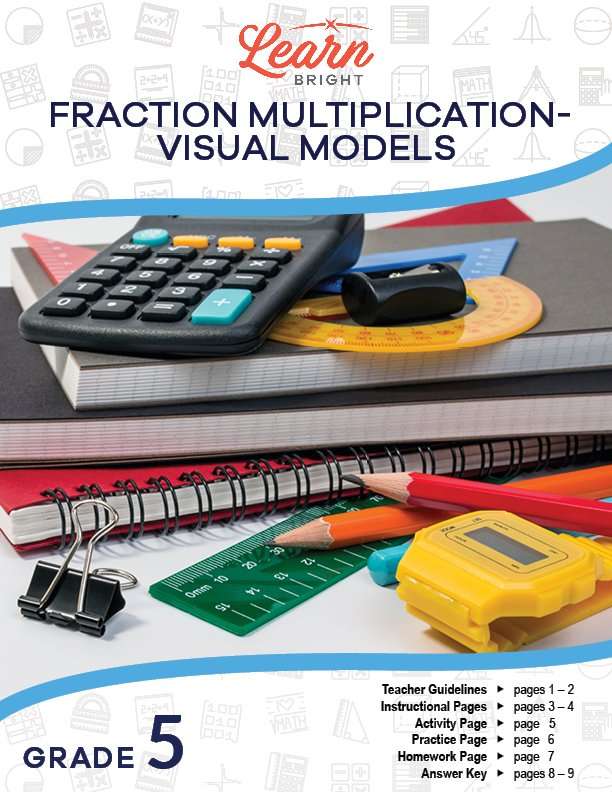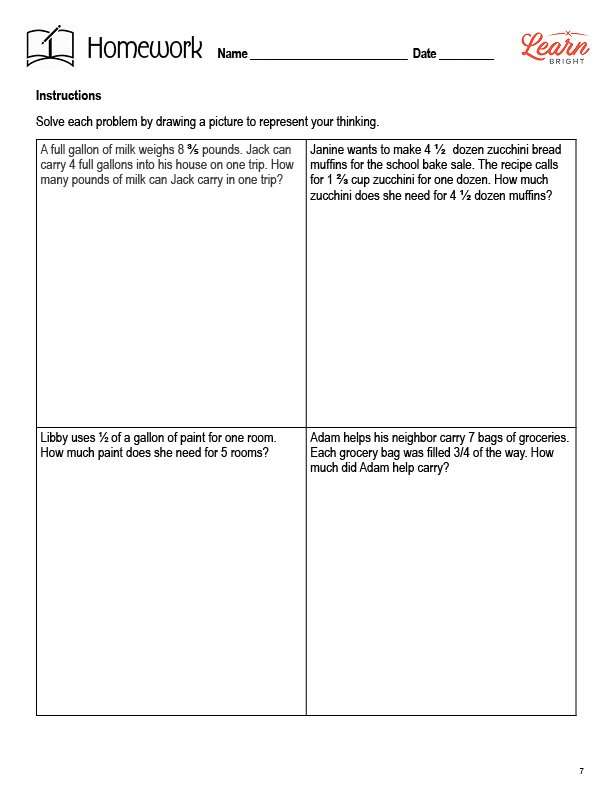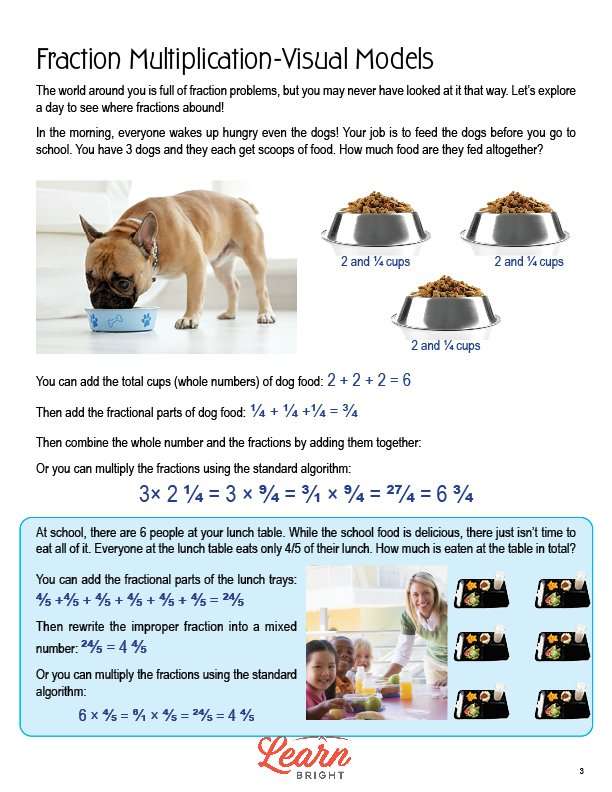Description
What our Fraction Multiplication – Visual Models lesson plan includes
Fraction Multiplication – Visual Models teaches students how to model fraction multiplication problems visually to solve them. At the end of the lesson, students will be able to solve real-world problems involving multiplication of fractions and mixed numbers. This lesson is for students in 5th grade.
Classroom Procedure
Every lesson plan provides you with a classroom procedure page that outlines a step-by-step guide to follow. You do not have to follow the guide exactly. The guide helps you organize the lesson and details when to hand out worksheets. It also lists information in the blue box that you might find useful. You will find the lesson objectives, state standards, and number of class sessions the lesson should take to complete in this area. In addition, it describes the supplies you will need as well as what and how you need to prepare beforehand. The only supplies you will need for this lesson are colored pencils. To prepare for this lesson ahead of time, you can gather the colored pencils and copy the handouts.
Options for Lesson
Included with this lesson is an “Options for Lesson” section that lists a number of suggestions for activities to add to the lesson or substitutions for the ones already in the lesson. One optional adjustment to this lesson is to let struggling students use their notes as a framework for writing their problems. You can also challenge students to use a fraction and a mixed number instead of a whole number. You can post the problems that they create around the classroom and have everyone solve them; you could also make a booklet with the problems for students to take home and solve during a school break.
Teacher Notes
The teacher notes page includes a paragraph with additional guidelines and things to think about as you begin to plan your lesson. This page also includes lines that you can use to add your own notes as you’re preparing for this lesson.
FRACTION MULTIPLICATION – VISUAL MODELS LESSON PLAN CONTENT PAGES
Fraction Multiplication – Visual Models
The Fraction Multiplication – Visual Models lesson plan includes two content pages. The lesson begins by telling students that the whole world around them is full of fraction problems, even if they’ve never noticed! The lesson walks them through a normal day that’s full of examples.
In the morning, you might feed your three dogs. Each dog gets 2 and 1/4 cups of food. How much food is that total? To figure that out, we can multiply fractions. First, you can add the total cups (whole numbers) together: 2 + 2 + 2 = 6. Next, you can add the fractional parts: 1/4 + 1/4 + 1/4 = 3/4. You can then add the whole number and fractions together to find the total: 6 + 3/4 = 6 3/4. Alternatively, you could multiply the fractions together using the standard algorithm: 3 x 2 1/4 = 3 x 9/4 = 3/1 x 9/4 = 27/4 = 6 3/4.
When you get to school, you eat lunch. There might be 6 people at your table, and each person only eats 4/5 of their lunch. You can add the fractional parts: 4/5 x 4/5 x 4/5 x 4/5 x 4/5 x 4/5 = 24/5. You’ll then rewrite the improper fraction as a mixed number: 24/5 = 4 4/5. Alternatively, you could multiply the fractions using the standard algorithm: 6 x 4/5 = 6/1 x 4/5 = 24/5 = 4 4/5.
Fraction Multiplication – Visual Models – Page Two
After school, you go to your grandmother’s house because she needs help with some boxes. She has 4 boxes that are filled to 1 1/3 times their size. To find the total, you can first add the total boxes (whole numbers): 1 + 1 + 1 + 1 =4. Next, you can add the fractional parts: 1/3 + 1/3 + 1/3 + 1/3 = 4/3. Then you’ll rewrite the improper fraction as a mixed number: 4/3 = 1 1/3. Finally, you can add them together: 4 + 1 1/3 = 5 1/3. Alternatively, you can multiply the fractions using the standard algorithm: 4 x 1 1/3 = 4 x 4/3 = 4/1 x 4/3 = 16/3 = 5 1/3.
We use fractions all the time! Students can try to think of some more examples of when they use and multiply fractions in their real life.
FRACTION MULTIPLICATION – VISUAL MODELS LESSON PLAN WORKSHEETS
The Fraction Multiplication – Visual Models lesson plan includes three worksheets: an activity worksheet, a practice worksheet, and a homework assignment. You can refer to the guide on the classroom procedure page to determine when to hand out each worksheet.
CREATING PROBLEMS ACTIVITY WORKSHEET
Students will work with a partner to complete this activity worksheet. They will first identify a topic that’s of interest to both of them. Next, they will think about how fractions can be multiplied using the topic they’ve picked. They will then write two problems like those down and will solve each problem using both a visual drawing and the standard algorithm.
WRITE A STORY PRACTICE WORKSHEET
The practice worksheet asks students to look at two fraction multiplication expressions and write a story to go with each. They will also draw a visual representation to show the solution.
FRACTION MULTIPLICATION – VISUAL MODELS HOMEWORK ASSIGNMENT
For the homework assignment, students will solve four fraction multiplication word problems, drawing a picture for each to represent their thinking.
Worksheet Answer Keys
This lesson plan includes answer keys for the practice worksheet and the homework assignment. If you choose to administer the lesson pages to your students via PDF, you will need to save a new file that omits these pages. Otherwise, you can simply print out the applicable pages and keep these as reference for yourself when grading assignments.









